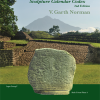Izapa Stela 12 encodes 52-year Calendar Round Dates calculated from the 365 day “haab” year: Autumn Equinox New Year –
1 Imox 4 Pop = 7.9.0.16.1 or Sept. 21, 176 BC
Cyclic renewal dedicatory date is 416 years from the Izapa base date of the Sun-Venus-Moon alignment on Sept. 21, 592 BC which celebrates 8 Calendar Rounds and 260 Venus Synodic cycles. This is the code for the 13th Calendar Round baktun World Ages history on Autumn Equinox 3120 BC to 2080 AD.
